Digital Transformation Report: Strategies and Technologies
VerifiedAdded on 2022/01/17
|9
|2416
|134
Report
AI Summary
This report provides a comprehensive overview of digital transformation in the business landscape. It begins with an introduction to the concept, emphasizing its importance for businesses to adapt and compete in the digital realm, covering the 5Ds of digital transformation: Devices, Platforms, Media, Data, and Technology. The report analyzes the impact of digital transformation on retail, contrasting online shopping with traditional high street stores and highlighting the rise of e-commerce giants. It then delves into specific new technologies, including Beacons, Facial Recognition, Robot Assistant Technology, Smart Mirrors, and Auto Checkout, discussing their advantages and disadvantages. The report further explores the 'Supermarket of the Future,' outlining potential improvements and the role of digital technologies in enhancing customer experience and operational efficiency. Finally, it addresses ethical considerations surrounding digital transformation, particularly data privacy and location tracking, and the importance of establishing ethical policies. The report concludes by highlighting the importance of streamlining operations and embracing automation to improve efficiency and customer value.

MB G 814
olanre a u disuw j
B00858154
olanre a u disuw j
B00858154
Paraphrase This Document
Need a fresh take? Get an instant paraphrase of this document with our AI Paraphraser
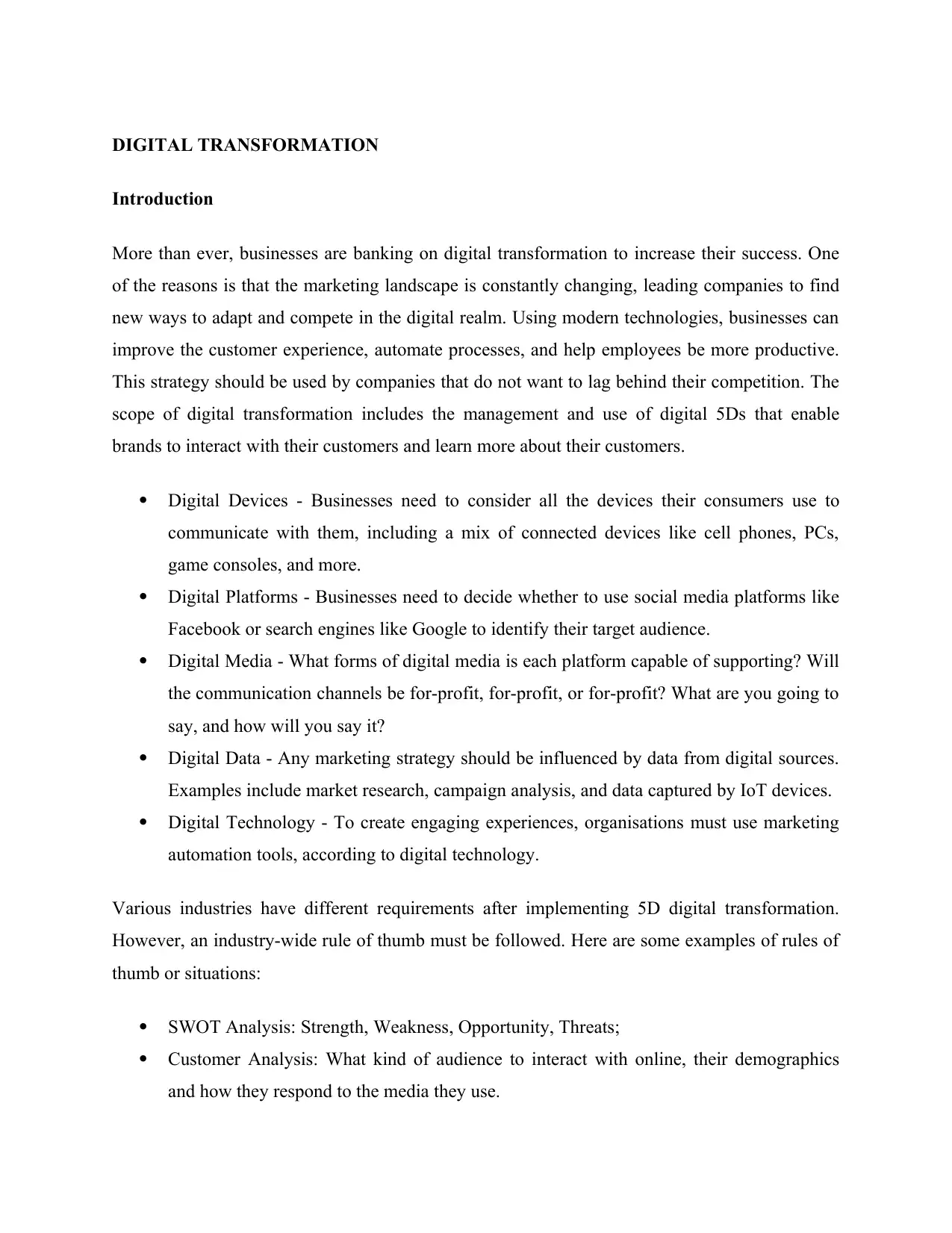
DIGITAL TRANSFORMATION
Introduction
More than ever, businesses are banking on digital transformation to increase their success. One
of the reasons is that the marketing landscape is constantly changing, leading companies to find
new ways to adapt and compete in the digital realm. Using modern technologies, businesses can
improve the customer experience, automate processes, and help employees be more productive.
This strategy should be used by companies that do not want to lag behind their competition. The
scope of digital transformation includes the management and use of digital 5Ds that enable
brands to interact with their customers and learn more about their customers.
Digital Devices - Businesses need to consider all the devices their consumers use to
communicate with them, including a mix of connected devices like cell phones, PCs,
game consoles, and more.
Digital Platforms - Businesses need to decide whether to use social media platforms like
Facebook or search engines like Google to identify their target audience.
Digital Media - What forms of digital media is each platform capable of supporting? Will
the communication channels be for-profit, for-profit, or for-profit? What are you going to
say, and how will you say it?
Digital Data - Any marketing strategy should be influenced by data from digital sources.
Examples include market research, campaign analysis, and data captured by IoT devices.
Digital Technology - To create engaging experiences, organisations must use marketing
automation tools, according to digital technology.
Various industries have different requirements after implementing 5D digital transformation.
However, an industry-wide rule of thumb must be followed. Here are some examples of rules of
thumb or situations:
SWOT Analysis: Strength, Weakness, Opportunity, Threats;
Customer Analysis: What kind of audience to interact with online, their demographics
and how they respond to the media they use.
Introduction
More than ever, businesses are banking on digital transformation to increase their success. One
of the reasons is that the marketing landscape is constantly changing, leading companies to find
new ways to adapt and compete in the digital realm. Using modern technologies, businesses can
improve the customer experience, automate processes, and help employees be more productive.
This strategy should be used by companies that do not want to lag behind their competition. The
scope of digital transformation includes the management and use of digital 5Ds that enable
brands to interact with their customers and learn more about their customers.
Digital Devices - Businesses need to consider all the devices their consumers use to
communicate with them, including a mix of connected devices like cell phones, PCs,
game consoles, and more.
Digital Platforms - Businesses need to decide whether to use social media platforms like
Facebook or search engines like Google to identify their target audience.
Digital Media - What forms of digital media is each platform capable of supporting? Will
the communication channels be for-profit, for-profit, or for-profit? What are you going to
say, and how will you say it?
Digital Data - Any marketing strategy should be influenced by data from digital sources.
Examples include market research, campaign analysis, and data captured by IoT devices.
Digital Technology - To create engaging experiences, organisations must use marketing
automation tools, according to digital technology.
Various industries have different requirements after implementing 5D digital transformation.
However, an industry-wide rule of thumb must be followed. Here are some examples of rules of
thumb or situations:
SWOT Analysis: Strength, Weakness, Opportunity, Threats;
Customer Analysis: What kind of audience to interact with online, their demographics
and how they respond to the media they use.
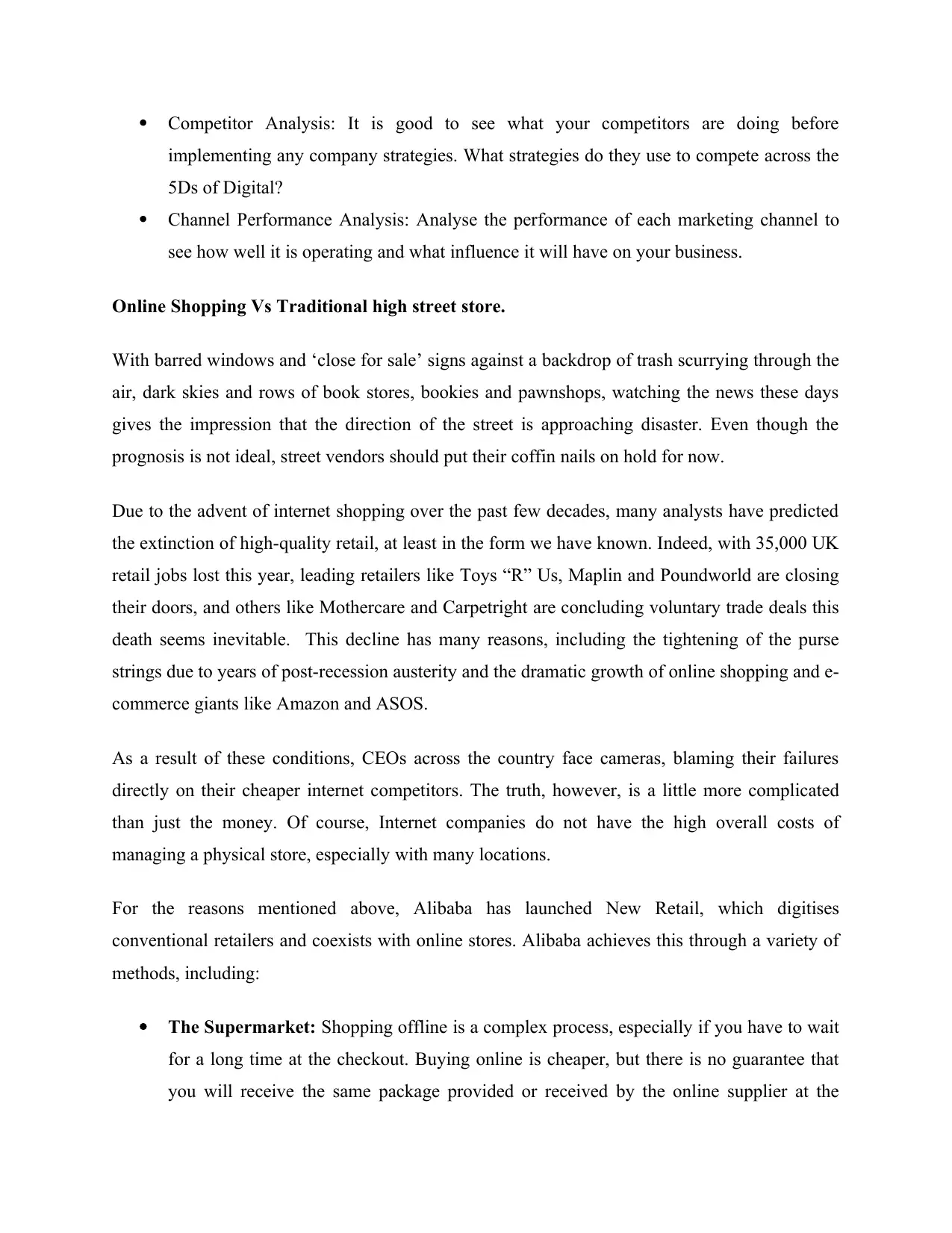
Competitor Analysis: It is good to see what your competitors are doing before
implementing any company strategies. What strategies do they use to compete across the
5Ds of Digital?
Channel Performance Analysis: Analyse the performance of each marketing channel to
see how well it is operating and what influence it will have on your business.
Online Shopping Vs Traditional high street store.
With barred windows and ‘close for sale’ signs against a backdrop of trash scurrying through the
air, dark skies and rows of book stores, bookies and pawnshops, watching the news these days
gives the impression that the direction of the street is approaching disaster. Even though the
prognosis is not ideal, street vendors should put their coffin nails on hold for now.
Due to the advent of internet shopping over the past few decades, many analysts have predicted
the extinction of high-quality retail, at least in the form we have known. Indeed, with 35,000 UK
retail jobs lost this year, leading retailers like Toys “R” Us, Maplin and Poundworld are closing
their doors, and others like Mothercare and Carpetright are concluding voluntary trade deals this
death seems inevitable. This decline has many reasons, including the tightening of the purse
strings due to years of post-recession austerity and the dramatic growth of online shopping and e-
commerce giants like Amazon and ASOS.
As a result of these conditions, CEOs across the country face cameras, blaming their failures
directly on their cheaper internet competitors. The truth, however, is a little more complicated
than just the money. Of course, Internet companies do not have the high overall costs of
managing a physical store, especially with many locations.
For the reasons mentioned above, Alibaba has launched New Retail, which digitises
conventional retailers and coexists with online stores. Alibaba achieves this through a variety of
methods, including:
The Supermarket: Shopping offline is a complex process, especially if you have to wait
for a long time at the checkout. Buying online is cheaper, but there is no guarantee that
you will receive the same package provided or received by the online supplier at the
implementing any company strategies. What strategies do they use to compete across the
5Ds of Digital?
Channel Performance Analysis: Analyse the performance of each marketing channel to
see how well it is operating and what influence it will have on your business.
Online Shopping Vs Traditional high street store.
With barred windows and ‘close for sale’ signs against a backdrop of trash scurrying through the
air, dark skies and rows of book stores, bookies and pawnshops, watching the news these days
gives the impression that the direction of the street is approaching disaster. Even though the
prognosis is not ideal, street vendors should put their coffin nails on hold for now.
Due to the advent of internet shopping over the past few decades, many analysts have predicted
the extinction of high-quality retail, at least in the form we have known. Indeed, with 35,000 UK
retail jobs lost this year, leading retailers like Toys “R” Us, Maplin and Poundworld are closing
their doors, and others like Mothercare and Carpetright are concluding voluntary trade deals this
death seems inevitable. This decline has many reasons, including the tightening of the purse
strings due to years of post-recession austerity and the dramatic growth of online shopping and e-
commerce giants like Amazon and ASOS.
As a result of these conditions, CEOs across the country face cameras, blaming their failures
directly on their cheaper internet competitors. The truth, however, is a little more complicated
than just the money. Of course, Internet companies do not have the high overall costs of
managing a physical store, especially with many locations.
For the reasons mentioned above, Alibaba has launched New Retail, which digitises
conventional retailers and coexists with online stores. Alibaba achieves this through a variety of
methods, including:
The Supermarket: Shopping offline is a complex process, especially if you have to wait
for a long time at the checkout. Buying online is cheaper, but there is no guarantee that
you will receive the same package provided or received by the online supplier at the
⊘ This is a preview!⊘
Do you want full access?
Subscribe today to unlock all pages.

Trusted by 1+ million students worldwide
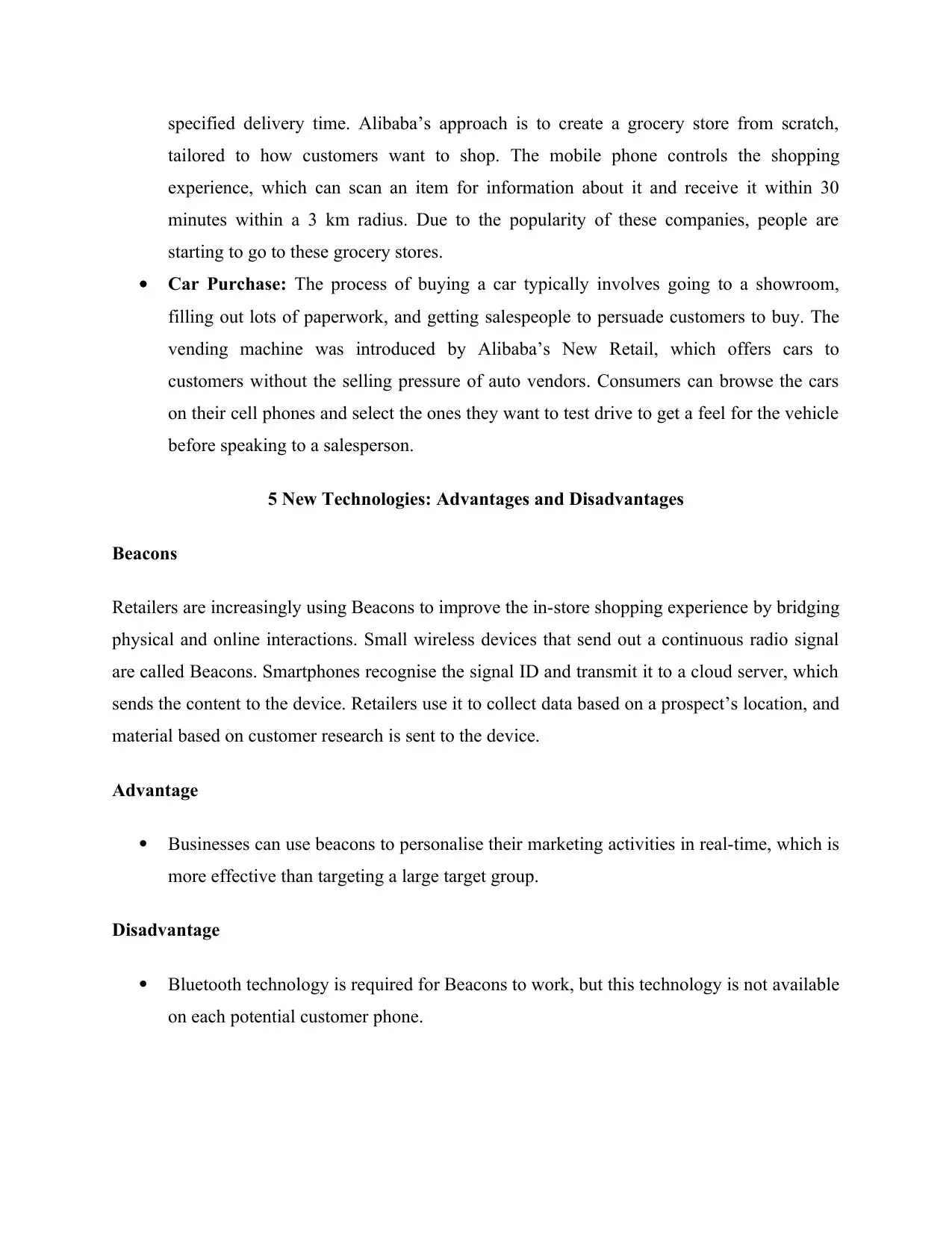
specified delivery time. Alibaba’s approach is to create a grocery store from scratch,
tailored to how customers want to shop. The mobile phone controls the shopping
experience, which can scan an item for information about it and receive it within 30
minutes within a 3 km radius. Due to the popularity of these companies, people are
starting to go to these grocery stores.
Car Purchase: The process of buying a car typically involves going to a showroom,
filling out lots of paperwork, and getting salespeople to persuade customers to buy. The
vending machine was introduced by Alibaba’s New Retail, which offers cars to
customers without the selling pressure of auto vendors. Consumers can browse the cars
on their cell phones and select the ones they want to test drive to get a feel for the vehicle
before speaking to a salesperson.
5 New Technologies: Advantages and Disadvantages
Beacons
Retailers are increasingly using Beacons to improve the in-store shopping experience by bridging
physical and online interactions. Small wireless devices that send out a continuous radio signal
are called Beacons. Smartphones recognise the signal ID and transmit it to a cloud server, which
sends the content to the device. Retailers use it to collect data based on a prospect’s location, and
material based on customer research is sent to the device.
Advantage
Businesses can use beacons to personalise their marketing activities in real-time, which is
more effective than targeting a large target group.
Disadvantage
Bluetooth technology is required for Beacons to work, but this technology is not available
on each potential customer phone.
tailored to how customers want to shop. The mobile phone controls the shopping
experience, which can scan an item for information about it and receive it within 30
minutes within a 3 km radius. Due to the popularity of these companies, people are
starting to go to these grocery stores.
Car Purchase: The process of buying a car typically involves going to a showroom,
filling out lots of paperwork, and getting salespeople to persuade customers to buy. The
vending machine was introduced by Alibaba’s New Retail, which offers cars to
customers without the selling pressure of auto vendors. Consumers can browse the cars
on their cell phones and select the ones they want to test drive to get a feel for the vehicle
before speaking to a salesperson.
5 New Technologies: Advantages and Disadvantages
Beacons
Retailers are increasingly using Beacons to improve the in-store shopping experience by bridging
physical and online interactions. Small wireless devices that send out a continuous radio signal
are called Beacons. Smartphones recognise the signal ID and transmit it to a cloud server, which
sends the content to the device. Retailers use it to collect data based on a prospect’s location, and
material based on customer research is sent to the device.
Advantage
Businesses can use beacons to personalise their marketing activities in real-time, which is
more effective than targeting a large target group.
Disadvantage
Bluetooth technology is required for Beacons to work, but this technology is not available
on each potential customer phone.
Paraphrase This Document
Need a fresh take? Get an instant paraphrase of this document with our AI Paraphraser
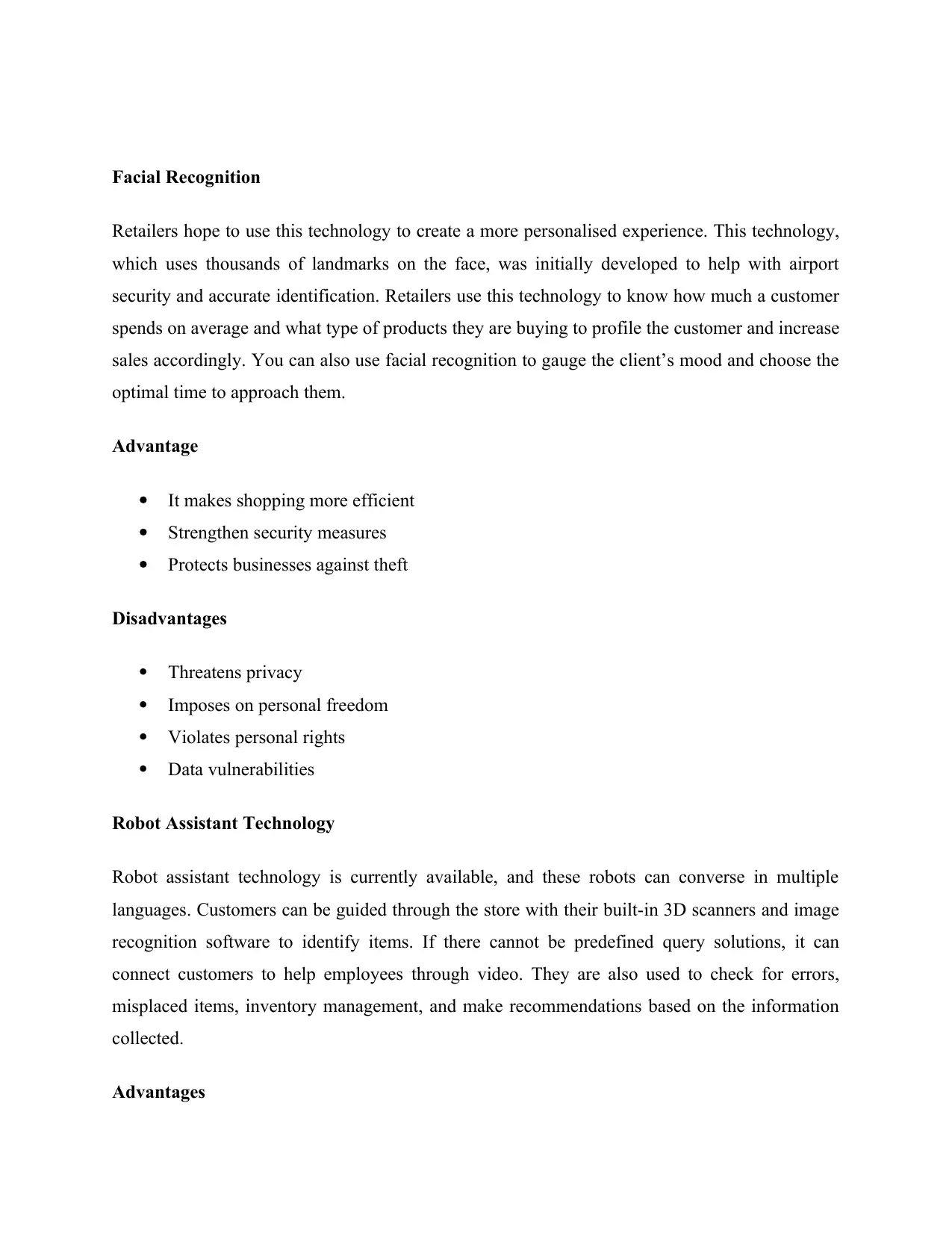
Facial Recognition
Retailers hope to use this technology to create a more personalised experience. This technology,
which uses thousands of landmarks on the face, was initially developed to help with airport
security and accurate identification. Retailers use this technology to know how much a customer
spends on average and what type of products they are buying to profile the customer and increase
sales accordingly. You can also use facial recognition to gauge the client’s mood and choose the
optimal time to approach them.
Advantage
It makes shopping more efficient
Strengthen security measures
Protects businesses against theft
Disadvantages
Threatens privacy
Imposes on personal freedom
Violates personal rights
Data vulnerabilities
Robot Assistant Technology
Robot assistant technology is currently available, and these robots can converse in multiple
languages. Customers can be guided through the store with their built-in 3D scanners and image
recognition software to identify items. If there cannot be predefined query solutions, it can
connect customers to help employees through video. They are also used to check for errors,
misplaced items, inventory management, and make recommendations based on the information
collected.
Advantages
Retailers hope to use this technology to create a more personalised experience. This technology,
which uses thousands of landmarks on the face, was initially developed to help with airport
security and accurate identification. Retailers use this technology to know how much a customer
spends on average and what type of products they are buying to profile the customer and increase
sales accordingly. You can also use facial recognition to gauge the client’s mood and choose the
optimal time to approach them.
Advantage
It makes shopping more efficient
Strengthen security measures
Protects businesses against theft
Disadvantages
Threatens privacy
Imposes on personal freedom
Violates personal rights
Data vulnerabilities
Robot Assistant Technology
Robot assistant technology is currently available, and these robots can converse in multiple
languages. Customers can be guided through the store with their built-in 3D scanners and image
recognition software to identify items. If there cannot be predefined query solutions, it can
connect customers to help employees through video. They are also used to check for errors,
misplaced items, inventory management, and make recommendations based on the information
collected.
Advantages
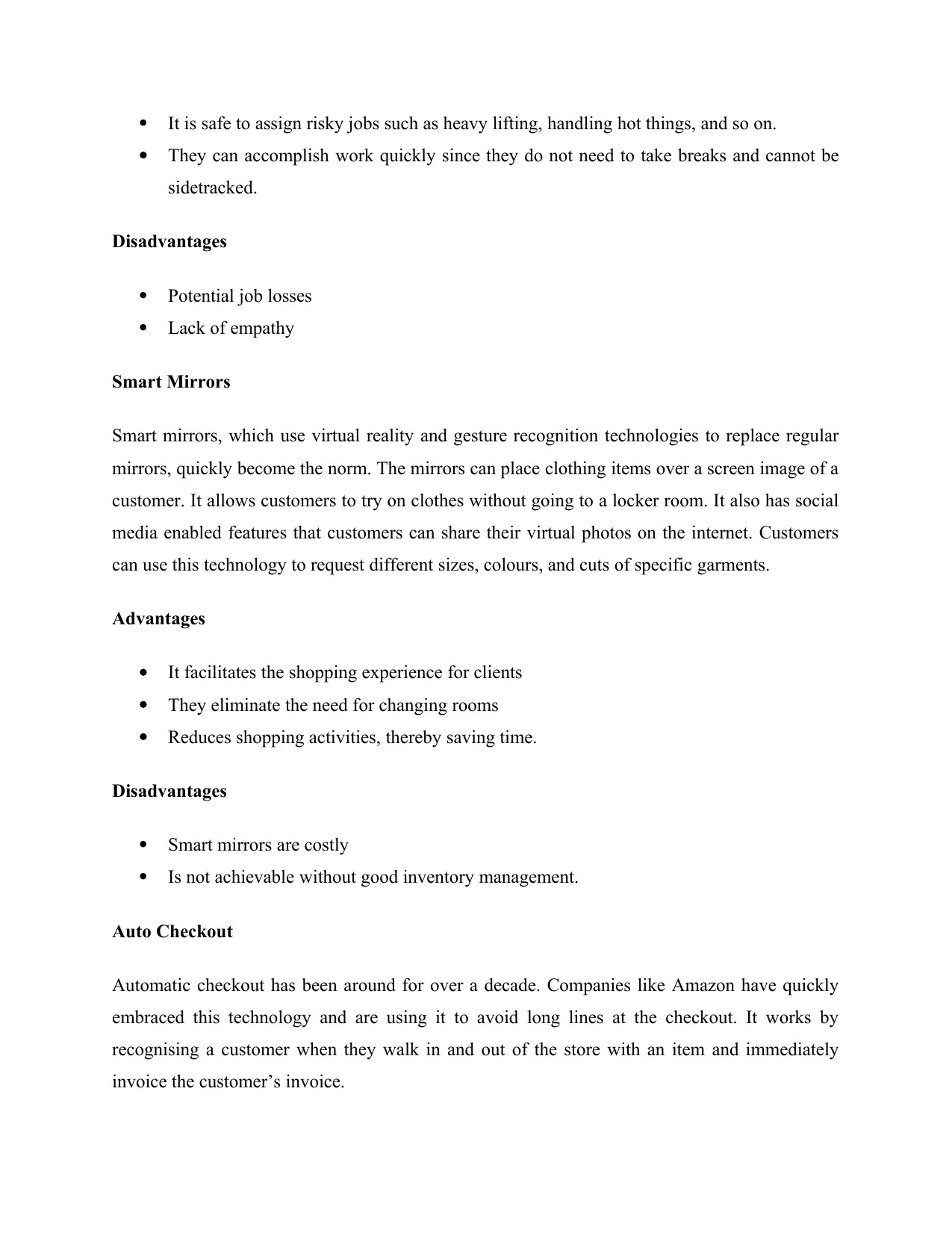
It is safe to assign risky jobs such as heavy lifting, handling hot things, and so on.
They can accomplish work quickly since they do not need to take breaks and cannot be
sidetracked.
Disadvantages
Potential job losses
Lack of empathy
Smart Mirrors
Smart mirrors, which use virtual reality and gesture recognition technologies to replace regular
mirrors, quickly become the norm. The mirrors can place clothing items over a screen image of a
customer. It allows customers to try on clothes without going to a locker room. It also has social
media enabled features that customers can share their virtual photos on the internet. Customers
can use this technology to request different sizes, colours, and cuts of specific garments.
Advantages
It facilitates the shopping experience for clients
They eliminate the need for changing rooms
Reduces shopping activities, thereby saving time.
Disadvantages
Smart mirrors are costly
Is not achievable without good inventory management.
Auto Checkout
Automatic checkout has been around for over a decade. Companies like Amazon have quickly
embraced this technology and are using it to avoid long lines at the checkout. It works by
recognising a customer when they walk in and out of the store with an item and immediately
invoice the customer’s invoice.
They can accomplish work quickly since they do not need to take breaks and cannot be
sidetracked.
Disadvantages
Potential job losses
Lack of empathy
Smart Mirrors
Smart mirrors, which use virtual reality and gesture recognition technologies to replace regular
mirrors, quickly become the norm. The mirrors can place clothing items over a screen image of a
customer. It allows customers to try on clothes without going to a locker room. It also has social
media enabled features that customers can share their virtual photos on the internet. Customers
can use this technology to request different sizes, colours, and cuts of specific garments.
Advantages
It facilitates the shopping experience for clients
They eliminate the need for changing rooms
Reduces shopping activities, thereby saving time.
Disadvantages
Smart mirrors are costly
Is not achievable without good inventory management.
Auto Checkout
Automatic checkout has been around for over a decade. Companies like Amazon have quickly
embraced this technology and are using it to avoid long lines at the checkout. It works by
recognising a customer when they walk in and out of the store with an item and immediately
invoice the customer’s invoice.
⊘ This is a preview!⊘
Do you want full access?
Subscribe today to unlock all pages.

Trusted by 1+ million students worldwide
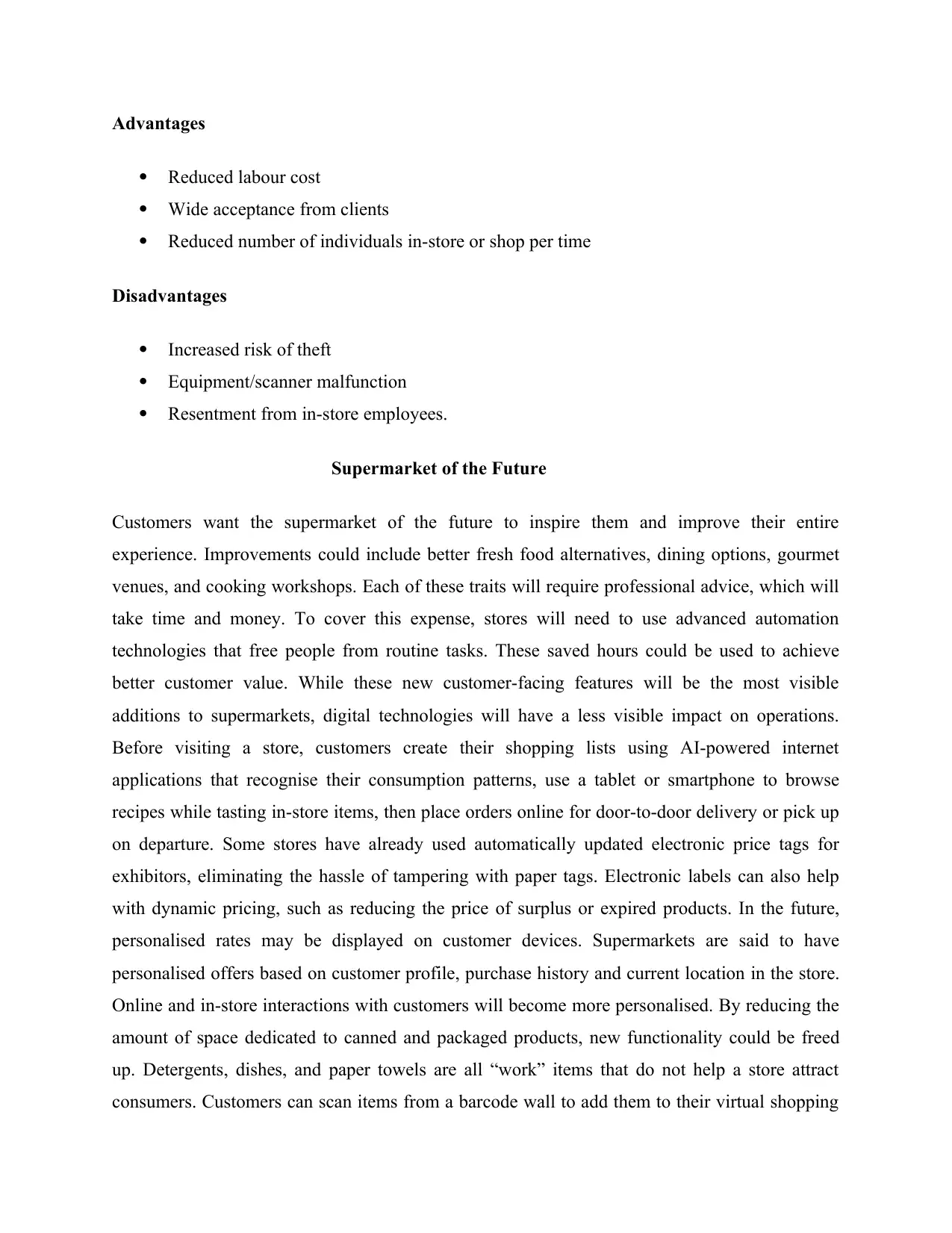
Advantages
Reduced labour cost
Wide acceptance from clients
Reduced number of individuals in-store or shop per time
Disadvantages
Increased risk of theft
Equipment/scanner malfunction
Resentment from in-store employees.
Supermarket of the Future
Customers want the supermarket of the future to inspire them and improve their entire
experience. Improvements could include better fresh food alternatives, dining options, gourmet
venues, and cooking workshops. Each of these traits will require professional advice, which will
take time and money. To cover this expense, stores will need to use advanced automation
technologies that free people from routine tasks. These saved hours could be used to achieve
better customer value. While these new customer-facing features will be the most visible
additions to supermarkets, digital technologies will have a less visible impact on operations.
Before visiting a store, customers create their shopping lists using AI-powered internet
applications that recognise their consumption patterns, use a tablet or smartphone to browse
recipes while tasting in-store items, then place orders online for door-to-door delivery or pick up
on departure. Some stores have already used automatically updated electronic price tags for
exhibitors, eliminating the hassle of tampering with paper tags. Electronic labels can also help
with dynamic pricing, such as reducing the price of surplus or expired products. In the future,
personalised rates may be displayed on customer devices. Supermarkets are said to have
personalised offers based on customer profile, purchase history and current location in the store.
Online and in-store interactions with customers will become more personalised. By reducing the
amount of space dedicated to canned and packaged products, new functionality could be freed
up. Detergents, dishes, and paper towels are all “work” items that do not help a store attract
consumers. Customers can scan items from a barcode wall to add them to their virtual shopping
Reduced labour cost
Wide acceptance from clients
Reduced number of individuals in-store or shop per time
Disadvantages
Increased risk of theft
Equipment/scanner malfunction
Resentment from in-store employees.
Supermarket of the Future
Customers want the supermarket of the future to inspire them and improve their entire
experience. Improvements could include better fresh food alternatives, dining options, gourmet
venues, and cooking workshops. Each of these traits will require professional advice, which will
take time and money. To cover this expense, stores will need to use advanced automation
technologies that free people from routine tasks. These saved hours could be used to achieve
better customer value. While these new customer-facing features will be the most visible
additions to supermarkets, digital technologies will have a less visible impact on operations.
Before visiting a store, customers create their shopping lists using AI-powered internet
applications that recognise their consumption patterns, use a tablet or smartphone to browse
recipes while tasting in-store items, then place orders online for door-to-door delivery or pick up
on departure. Some stores have already used automatically updated electronic price tags for
exhibitors, eliminating the hassle of tampering with paper tags. Electronic labels can also help
with dynamic pricing, such as reducing the price of surplus or expired products. In the future,
personalised rates may be displayed on customer devices. Supermarkets are said to have
personalised offers based on customer profile, purchase history and current location in the store.
Online and in-store interactions with customers will become more personalised. By reducing the
amount of space dedicated to canned and packaged products, new functionality could be freed
up. Detergents, dishes, and paper towels are all “work” items that do not help a store attract
consumers. Customers can scan items from a barcode wall to add them to their virtual shopping
Paraphrase This Document
Need a fresh take? Get an instant paraphrase of this document with our AI Paraphraser
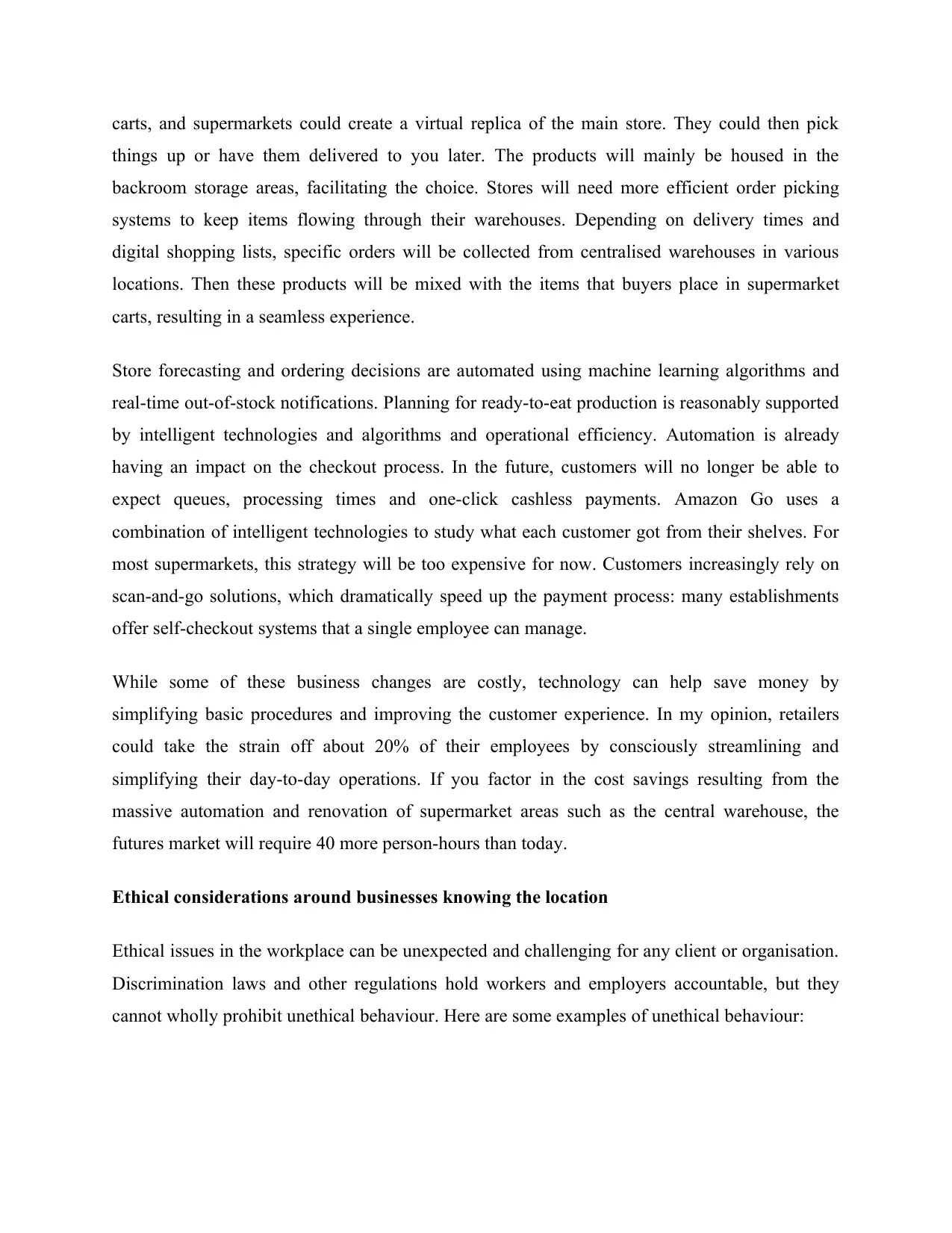
carts, and supermarkets could create a virtual replica of the main store. They could then pick
things up or have them delivered to you later. The products will mainly be housed in the
backroom storage areas, facilitating the choice. Stores will need more efficient order picking
systems to keep items flowing through their warehouses. Depending on delivery times and
digital shopping lists, specific orders will be collected from centralised warehouses in various
locations. Then these products will be mixed with the items that buyers place in supermarket
carts, resulting in a seamless experience.
Store forecasting and ordering decisions are automated using machine learning algorithms and
real-time out-of-stock notifications. Planning for ready-to-eat production is reasonably supported
by intelligent technologies and algorithms and operational efficiency. Automation is already
having an impact on the checkout process. In the future, customers will no longer be able to
expect queues, processing times and one-click cashless payments. Amazon Go uses a
combination of intelligent technologies to study what each customer got from their shelves. For
most supermarkets, this strategy will be too expensive for now. Customers increasingly rely on
scan-and-go solutions, which dramatically speed up the payment process: many establishments
offer self-checkout systems that a single employee can manage.
While some of these business changes are costly, technology can help save money by
simplifying basic procedures and improving the customer experience. In my opinion, retailers
could take the strain off about 20% of their employees by consciously streamlining and
simplifying their day-to-day operations. If you factor in the cost savings resulting from the
massive automation and renovation of supermarket areas such as the central warehouse, the
futures market will require 40 more person-hours than today.
Ethical considerations around businesses knowing the location
Ethical issues in the workplace can be unexpected and challenging for any client or organisation.
Discrimination laws and other regulations hold workers and employers accountable, but they
cannot wholly prohibit unethical behaviour. Here are some examples of unethical behaviour:
things up or have them delivered to you later. The products will mainly be housed in the
backroom storage areas, facilitating the choice. Stores will need more efficient order picking
systems to keep items flowing through their warehouses. Depending on delivery times and
digital shopping lists, specific orders will be collected from centralised warehouses in various
locations. Then these products will be mixed with the items that buyers place in supermarket
carts, resulting in a seamless experience.
Store forecasting and ordering decisions are automated using machine learning algorithms and
real-time out-of-stock notifications. Planning for ready-to-eat production is reasonably supported
by intelligent technologies and algorithms and operational efficiency. Automation is already
having an impact on the checkout process. In the future, customers will no longer be able to
expect queues, processing times and one-click cashless payments. Amazon Go uses a
combination of intelligent technologies to study what each customer got from their shelves. For
most supermarkets, this strategy will be too expensive for now. Customers increasingly rely on
scan-and-go solutions, which dramatically speed up the payment process: many establishments
offer self-checkout systems that a single employee can manage.
While some of these business changes are costly, technology can help save money by
simplifying basic procedures and improving the customer experience. In my opinion, retailers
could take the strain off about 20% of their employees by consciously streamlining and
simplifying their day-to-day operations. If you factor in the cost savings resulting from the
massive automation and renovation of supermarket areas such as the central warehouse, the
futures market will require 40 more person-hours than today.
Ethical considerations around businesses knowing the location
Ethical issues in the workplace can be unexpected and challenging for any client or organisation.
Discrimination laws and other regulations hold workers and employers accountable, but they
cannot wholly prohibit unethical behaviour. Here are some examples of unethical behaviour:
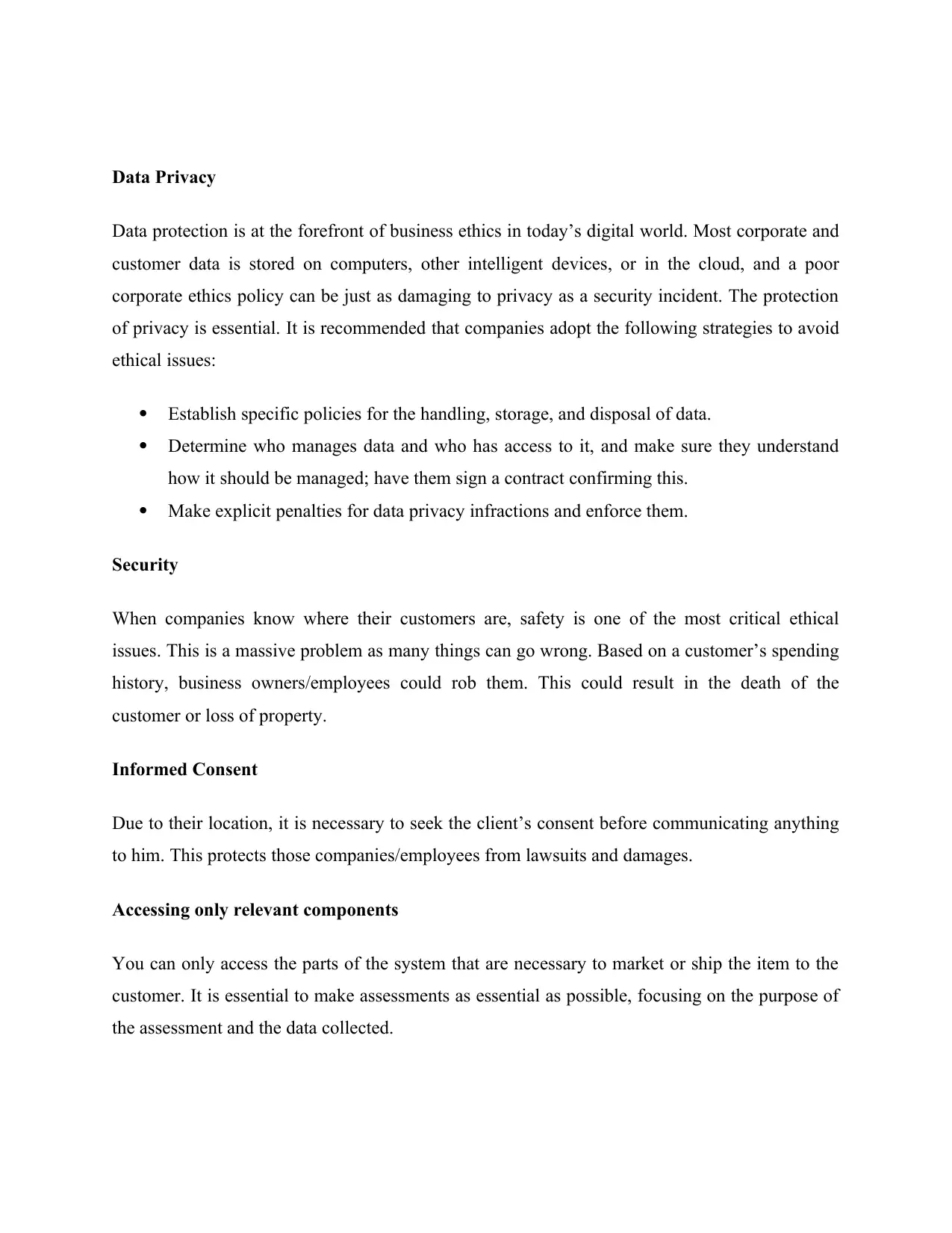
Data Privacy
Data protection is at the forefront of business ethics in today’s digital world. Most corporate and
customer data is stored on computers, other intelligent devices, or in the cloud, and a poor
corporate ethics policy can be just as damaging to privacy as a security incident. The protection
of privacy is essential. It is recommended that companies adopt the following strategies to avoid
ethical issues:
Establish specific policies for the handling, storage, and disposal of data.
Determine who manages data and who has access to it, and make sure they understand
how it should be managed; have them sign a contract confirming this.
Make explicit penalties for data privacy infractions and enforce them.
Security
When companies know where their customers are, safety is one of the most critical ethical
issues. This is a massive problem as many things can go wrong. Based on a customer’s spending
history, business owners/employees could rob them. This could result in the death of the
customer or loss of property.
Informed Consent
Due to their location, it is necessary to seek the client’s consent before communicating anything
to him. This protects those companies/employees from lawsuits and damages.
Accessing only relevant components
You can only access the parts of the system that are necessary to market or ship the item to the
customer. It is essential to make assessments as essential as possible, focusing on the purpose of
the assessment and the data collected.
Data protection is at the forefront of business ethics in today’s digital world. Most corporate and
customer data is stored on computers, other intelligent devices, or in the cloud, and a poor
corporate ethics policy can be just as damaging to privacy as a security incident. The protection
of privacy is essential. It is recommended that companies adopt the following strategies to avoid
ethical issues:
Establish specific policies for the handling, storage, and disposal of data.
Determine who manages data and who has access to it, and make sure they understand
how it should be managed; have them sign a contract confirming this.
Make explicit penalties for data privacy infractions and enforce them.
Security
When companies know where their customers are, safety is one of the most critical ethical
issues. This is a massive problem as many things can go wrong. Based on a customer’s spending
history, business owners/employees could rob them. This could result in the death of the
customer or loss of property.
Informed Consent
Due to their location, it is necessary to seek the client’s consent before communicating anything
to him. This protects those companies/employees from lawsuits and damages.
Accessing only relevant components
You can only access the parts of the system that are necessary to market or ship the item to the
customer. It is essential to make assessments as essential as possible, focusing on the purpose of
the assessment and the data collected.
⊘ This is a preview!⊘
Do you want full access?
Subscribe today to unlock all pages.

Trusted by 1+ million students worldwide
1 out of 9
Related Documents
Your All-in-One AI-Powered Toolkit for Academic Success.
+13062052269
info@desklib.com
Available 24*7 on WhatsApp / Email
![[object Object]](/_next/static/media/star-bottom.7253800d.svg)
Unlock your academic potential
Copyright © 2020–2025 A2Z Services. All Rights Reserved. Developed and managed by ZUCOL.




